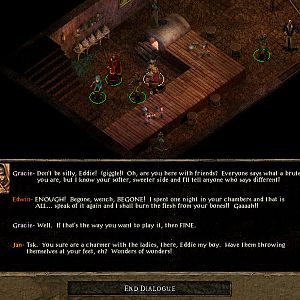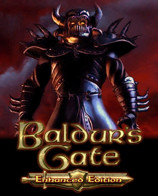-

- Forums
- Chatrooms
- Gallery
- Gameplay Videos
- Upload
- Articles
- Mod Reviews
- Shop SP: Games, Movies, Books

Ferofist, Male Dwarven Cleric of Moradin 10
 Alignment:
Lawful Good
Alignment:
Lawful Good
Strength:
16
Intelligence: 12
Constitution: 17
Wisdom: 17
Dexterity: 14
Charisma: 15
1) Why He’s Included
With the exception of my Paladin, I named my characters after the members of the fallen pantheon from Bard’s Tale 3. Just a little ‘for your information’. Whether it's healing wounds, or curing various afflictions, Clerics are the best healers in the D&D rule system. They also come with a variety of spells that bolster the party’s defences. ToEE offers a wide variety of clerical abilities depending on the patron deity chosen for the Cleric.
I went with the Cleric of Moradin for a number of reasons. My Paladin is the only dedicated fighter present in the party. As such I try to develop my Cleric, the only other character who can wear plate armor effectively, in such a way that he can participate in melee combat meaningfully. This need is more acutely felt for my party having 5 members in it instead of the usual 6. In this regard, the Cleric of Moradin is ideal. A Dwarf with a high Constitution score will be able to withstand a considerable amount of punishment. The Constitution score will also enable him to succeed at his Concentration checks to avoid having his spells being disrupted. With the right feat, he’ll be able to make full use of the powerful Great Cleaver, found later in the game. The Cleric of Moradin is also able to cast Stoneskin upon reaching the 9th level. The ability to use this spell in conjunction with wearing plate armor and a shield is a considerable boon indeed.
2) Ability Score Increases
4th / +1 to Constitution
Perfectly logical, since it will increase his Fortitude saving throws, and his Hit Points.
8th / +1 to Wisdom
Emphasizing Wisdom increases the Cleric’s Will saves, increases the number of spells he can prepare, and increases the Difficulty Class of his spells when enemy targets are forced to make a saving throw against them.
3) Skills
Concentration – A thoroughly logical choice for any spellcasting profession. Sometimes you just can’t avoid an attack of opportunity, or Cast Defensively, or otherwise avoid the need to make this skill check.
Heal – Sometimes a character is going to hit 0 hit points. From that point onwards, the character is going to lose 1 hit point every round. Once hit points reach -10, that character will die. The Heal skill is readily available to prevent this. Divine spellcasters, with their high Wisdom score, are ideal candidates for this skill.
4) Feats
1st Level / Improved Initiative
For any spellcasting class, the ability to get off a spell first before monsters can close in and threaten attacks of opportunity, or otherwise take the initiative, is of great importance.
3rd Level / Combat Casting
Sometimes casting a spell in the heat of combat just can’t be avoided. This is especially true for the Cleric. Often the Cleric may very well have to risk an attack of opportunity in order to revive a comrade in peril. Anything that can be done to improve the chances of making that Concentration check should be done.
6th Level / Martial Weapon Proficiency: Handaxe
This allows my cleric to wield the powerful Great Cleaver without any penalty.
9th Level / Craft Magic Arms and Armor
I previously had Ferofist acquire Lightning Reflexes in order to mitigate a bad Reflex Saving Throw bonus. I reasoned that since he’ll eventually find an item that boosts his saving throws later in the game, I could go with something else. I went with Craft Magic Arms and Armor. Sure, Valarian will have it. But it often helps to have a character with priestly spells who is able to enchant items as well. Ferofist selects the Earth and Good Domains. As such, he is able to imbue weapons with the Holy property, allowing such weapons to score an extra 2d6 of damage against evil targets.
Feats not Included /
Extra Turning, Improved Turning – I’ve never been a big fan of turning the undead. My preference is to hack them apart with anti-undead weapons, or blow them away with anti-undead spells (e.g. Sunray).
Silent Spell – I’m not a big fan of feats that require you to expend high spell-level slots either. As far as I know, Silence is the only 3.5e spell that poses this threat. Being a 2nd level spell, the Difficulty Class to save against it will be rather easy. Add to that the fact that my Cleric has a high Wisdom score, I figure I shouldn’t bother.
Still Spell – Similar logic as with Silent Spell. I reason that my Cleric shouldn’t need it once he finds a Ring of Free Action.
5) Spell Selection
I won’t be delineating with precision the full details of how my cleric prepares his spells. I’m content to provide some general guidelines. There are some bases that you need to cover:
Healing Spells – Spells that restore lost hit points are a must. Not only do they save you a load of time while resting, they can also become crucial when party members are very close to having their hit points brought to zero.
Curative Spells – Neutralize Poison, Remove Disease, Remove Blindness, etc. The Cleric should come ready with an answer for anything that afflicts his comrades. Disease is an especially serious concern in ToEE. Diseases have an incubation period of a day or more, such that you won’t notice it until much later. Among the effects are permanent loss of ability points, something you definitely don’t want to happen.
Protective Spells – Have at least a couple of spells in store that beef up your defences. Magic Circle Against Evil is ideal to protect multiple party members, and its duration is long enough to justify casting it before you enter a dungeon. Death Ward and Spell Resistance also suggest themselves. With the Cleric of Moradin, a great boon is the ability to couple the Stoneskin spell with the wearing of plate armor and a shield.
Combat Buffers – Since the cleric has to shoulder physical combat at times, it often makes sense to carry a spell or two that augment his fighting prowess. Spells like Divine Power and Dispel Evil recommend themselves.


